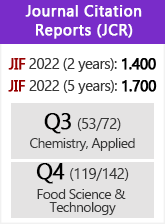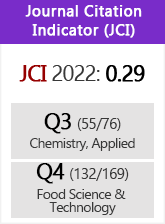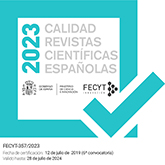Development of zero-trans shortenings with high thermo-oxidative stability by enzymatic transesterification
DOI:
https://doi.org/10.3989/gya.0564191Keywords:
Canola oil, Enzymatic transesterification, Frying, Palm stearin, Stearic acid, Zero-trans shorteningAbstract
Novel zero-trans frying shortenings were formed by enzymatic transesterification by exploring a palm stearin and canola oil mixture and stearic acid as substrates. Both immobilized (Novozym 435, Lipase PS “Amano” IM) and non-immobilized (Lipomod TM 34P) enzymes were applied as biocatalysts. Palmitic acid, the fatty acid which defines the proper type of crystal formation, was present at the 15% level in the reaction mixtures. The novel structured lipids had comparable physical properties and offered similar frying performance to those of commercial shortening. Needle-shaped crystals were predominant both in the transesterification products and the commercial frying shortening. Furthermore, solid fat content profiles of the zero-trans structured lipids produced by Novozym 435 and Lipase PS “Amano” IM were close to those of the commercial shortening.
Downloads
References
Ahmadi L, Marangoni AG. 2009. Functionality and physical properties of interesterified high oleic shortening structured with stearic acid. Food Chem. 117, 668-673. https://doi.org/10.1016/j.foodchem.2009.04.072
Aladedunye F, Gruczynska E. 2019. Configuring phenolic antioxidants for frying applications, in Varelis P, Melton L, Shahidi F (Eds.). Encyclopedia of Food Chemistry. Elsevier, 54-62. https://doi.org/10.1016/B978-0-08-100596-5.21659-4
Aladedunye FA, Przybylski R. 2011. Rapid assessment of frying performance using small size samples of oils/fats. J. Am. Oil Chem. Soc. 88, 1867-1873. https://doi.org/10.1007/s11746-011-1874-0
AOAC. 1990. Official methods of analysis of the Association of Official Analytical Chemists. 15th ed. Arlington, VA, USA.
Barrera-Arellano D, Ruiz-Méndez V, Velasco J, Márquez-Ruiz G, Dobarganes C. 2002. Loss of tocopherols and formation of degradation compounds at frying temperatures in oils differing in degree of unsaturation and natural antioxidant content. J. Sci. Food Agric. 82, 1696-1702. https://doi.org/10.1002/jsfa.1245
Bonanom A, Grundy SM. 1988. Effect of dietary stearic acid on plasma cholesterol and lipoprotein levels. N. Engl. J. Med. 318, 1244-1248. https://doi.org/10.1056/NEJM198805123181905 PMid:3362176
Chavarro JE, Stampfer MJ, Campos H, Kurth T, Willett WC, Ma J. 2008. A prospective study of trans-fatty acid levels in blood and risk of prostate cancer. Cancer Epidemiol. Biomarkers Prev. 17, 95-101. https://doi.org/10.1158/1055-9965.EPI-07-0673 PMid:18199715
deMan JM. 1992. X-ray diffraction spectroscopy in the study of fat polymorphism. Food Res. Int. 25, 471−476. https://doi.org/10.1016/0963-9969(92)90172-2
Eckel RH, Borra S, Lichtenstein AH, Yin-Piazza SY. 2007. Understanding the complexity of trans fatty acid reduction in the American diet: American Heart Association Trans Fat Conference 2006: Report of the Trans Fat Conference Planning Group. Circulation 115, 2231-2246. https://doi.org/10.1161/CIRCULATIONAHA.106.181947 PMid:17426064
Firestone D. 2009. Official Methods and Recommended Practices of the American Oil Chemists' Society. 6th ed. Champaign, IL, USA.
Food & Drug Administration. 2003. Guidance for Industry. Food Labelling: Trans Fatty Acids in Nutrition Labelling, Nutrient Content Claims, and Health Claims. US Department of Health and Human Services. Federal Register 68, 41433-41506.
Gupta MK. 2017. Trans fats alternatives and challenges, in Gupta MK (Ed.) Practical Guide to Vegetable Oil Processing. AOCS Press, 341-374. https://doi.org/10.1016/B978-1-63067-050-4.00013-1
Hegsted DM, McGandy RB, Myers ML, Stare FJ. 1965. Quantitative effects of dietary fat on serum cholesterol in man. Am. J. Clin. Nutr. 17, 281-295. https://doi.org/10.1093/ajcn/17.5.281 PMid:5846902
Idris NA, Berger KG, Ong ASH. 1989. Evaluation of shortenings based on various palm oil products. J Sci. Food Agric. 46, 481-493. https://doi.org/10.1002/jsfa.2740460410
ISO. 2007. Animal and Vegetable Fats and Oils - Determination of Polymerized Triglycerides Content by High Performance Size Exclusion Chromatography (HPSEC). Geneva, International Organization for Standardization [Standard 16931].
Kowalska D, Kostecka M, Tarnowska K, Kowalski B. 2014. Oxidative stabilities of enzymatically interesterified goose fat and rapeseed oil blend by rancimat and PDSC. J. Therm. Anal. Calorim. 115, 2063-2070. https://doi.org/10.1007/s10973-013-3125-0
Kowalski B, Tarnowska K, Gruczyńska E, Bekas W. 2004. Chemical and enzymatic interesterification of a beef tallow and rapeseed oil equal-weight blend. Eur. J. Lipid Sci. Technol. 106, 655-664. https://doi.org/10.1002/ejlt.200400973
Lichtenstein AH, Appel LJ, Brands M, Carnethon M, Daniels S, Franch HA, Franklin B, Kris-Etherton P, Harris WS, Howard B, Karanja N, Lefevre M, Rudel L, Sacks F, Van Horn L, Winston M, Wylie-Rosett J. 2006. Diet and lifestyle recommendations. Circulation 114, 82-96. https://doi.org/10.1161/CIRCULATIONAHA.106.176158 PMid:16785338
Marmesat S, Morales A, Velasco J, Dobarganes MC. 2010. Action and fate of natural and synthetic antioxidants during frying. Grasas Aceites 61, 333-340. https://doi.org/10.3989/gya.021910
Martin JC, Dobarganes MC, Nour M, Márquez-Ruiz G, Christie WW, Lavillonnière F, Sébédio JL. 1998. Effect of fatty acid positional distribution and triacylglycerol composition on lipid by-products formation during heat treatment: I. Polymer formation. J. Am. Oil Chem. Soc. 75, 1065-1071. https://doi.org/10.1007/s11746-998-0114-8
Metzroth D. 2005. Shortenings: Science and technology, in Shahidi F (Ed.) Bailey's Industrial Oil and Fat Products. A John Wiley & Sons Inc., Hoboken, New Jersey. https://doi.org/10.1002/047167849X.bio044
Przybylski R, Zambiazi RC. 2000. Predicting oxidative stability of vegetable oils using neural network system and endogenous oil components. J. Am. Oil Chem. Soc. 77, 925-931. https://doi.org/10.1007/s11746-000-0146-x
Seppanen CM, Song Q, Csallany AS. 2010. The antioxidant functions of tocopherol and tocotrienol homologues in oils, fats, and food system. J. Am. Oil Chem. Soc. 87, 469-481. https://doi.org/10.1007/s11746-009-1526-9
Stier RF. 2013. Ensuring the health and safety of fried foods. Eur. J. Lipid Sci. Technol. 115, 956-964. https://doi.org/10.1002/ejlt.201300180
Uauy R, Aro A, Clarke R, Ghafoorunissa R, L'Abbé M, Mozaffarian D, Skeaff M, Stender S, Tavellaet M. 2009. WHO scientific update on trans fatty acids: summary and conclusions. Eur. J. Clin. Nutr. 63, S68-S75. https://doi.org/10.1038/ejcn.2009.15
Verleyen T, Kamal-Eldin A, Mozuraityte R, Verhe R, Dewettinck K, Huyghebaert A, De Greyt W. 2002. Oxidation at elevated temperatures: competition between a-tocopherol and unsaturated triacylglycerols. Eur. J. Lipid Sci. Technol. 104, 228-233. https://doi.org/10.1002/1438-9312(200204)104:4<228::AID-EJLT228>3.0.CO;2-5
Published
How to Cite
Issue
Section
License
Copyright (c) 2020 Consejo Superior de Investigaciones Científicas (CSIC)

This work is licensed under a Creative Commons Attribution 4.0 International License.
© CSIC. Manuscripts published in both the printed and online versions of this Journal are the property of Consejo Superior de Investigaciones Científicas, and quoting this source is a requirement for any partial or full reproduction.All contents of this electronic edition, except where otherwise noted, are distributed under a “Creative Commons Attribution 4.0 International” (CC BY 4.0) License. You may read here the basic information and the legal text of the license. The indication of the CC BY 4.0 License must be expressly stated in this way when necessary.
Self-archiving in repositories, personal webpages or similar, of any version other than the published by the Editor, is not allowed.
















